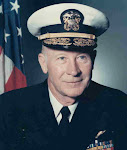Seventy years ago tonight, as
this is written, twenty-nine year old LTjg Jackson D. Arnold, USN, USNA Class
of 1934, an Engineering Test Pilot assigned to Ford Island in the middle of
Pearl Harbor was at one of the usual Saturday night parties very common at the
time. He and his new girlfriend
Muriel McChesney would not get home until early the next morning. No problems, it was going to be a lazy
Sunday. He could sleep in. Jack was, in today’s terms, a Party
Animal. He dropped off Muriel at
her home a mile or so away near the foot of Diamond Head and went home to what
might be generously called sleep.
Things were good, things were stable. All was well.
Things would change. Change faster than Jack could imagine.
Just before 0800, Jack awoke to
the biggest bang he had heard since he was the Officer in Charge of ARIZONA’s
Number Four Turret. He rolled out
of bed, ran out side and looked up.
Divebombers, rolling in on Pearl Harbor, meatballs on their sides. The bang had been a Jap mistaking his
pickle button for a radio key. A
500 pounder fell a few hundred feet from his front lanai. He ran back inside, put on his khaki
uniform, grabbed his desktop radio and headed towards Pearl, with a quick stop
to give Muriel the radio and tell her to keep her wits about her and listen to
the radio.
Into his car and towards
Pearl. As he raced along what is
now Nimitz Highway, through the cane fields, a military staff car pulled in
front of him, shortly thereafter a truck pulled in behind him. A convoy of three. Soon a Zero found them, rolling in, he
strafed the staff car, which ran off into the cane fields. The Jap came back around and rolled in
on the truck, riddled with bullets, it went off burning into the cane
fields. Jack had had enough of
that, he pulled off the road and dove under the car. After about two minutes, it came to him; there he was
under the only potential target.
He decided he would more likely survive if he were a moving target and
not hiding under the gas tank.
Back on the road! In a few
minutes he came to the Pearl Boat Facility where he looked for a launch to Ford
Island. No launches! Then, he looked in the boat shed. It was full of launches and cowering coxswains.
Jack jumped into the launch
closest to the open boat house door.
A coxswain came out, “You can’t take that, she’s mine.” Jack said, “Well, she’s going to Ford
Island.” “Not without me driving,”
as the coxswain hopped aboard and started her.
Arriving at Ford Island in the
middle of the first wave, Jack sprinted across the field, scrambled into the
only flyable F-4F Wildat and got her running. A plane captain clambered up the side of the running
aircraft to tell him that not only was the aircraft very low on fuel, but it
was totally devoid of ammunition.
So much for his first air to air victory. With no other flyable aircraft remaining, he looked about
for a way to “contribute to the war effort.”
Just before the second wave hit, Jack
came across a young Marine who had lost his life in the first wave attack, but
kept his BAR from hitting the ground.
Jack, having been on the All Navy Rifle and Pistol Teams and an avid
bird hunter felt at home with the Browning. As he stood there near the base of the new tower, a lone
torpedo bomber rolled in to strafe the tower and thus him. Judging his lead carefully, he emptied
two magazines into the Jap, killing the pilot and severing a line or two. Smoke and flame poured from the plane
as it crashed on the field. The second
wave was gone. Jack went over to
the wreck, it was the Torpedo Squadron Commander. Jack took a bottle of sake from the plane, they would not
need it now. He took a big gulp,
passed it to sailors gathering to see what he had found, and ran back to the
whaleboat he had taken to Ford Island.
Grabbing the launch, he put out
for ARIZONA to pick up survivors.
The first person he pulled from the water exclaimed, “Mr. Arnold! Mr.
Arnold! Mr. Arnold!” Looking at
the man, covered head to toe in bunkers, black as a seal, Jack responded, “Sir,
you have the advantage of me. Who
the blazes are you?” The slippery
dark form responded, “Sir, it is me, Johnson.” The Number Four Turret Captain, the Petty Officer with whom
Jack had worked on his first assignment out of the Naval Academy.
Things would change for
Jack. In five weeks, he would
marry his new girl friend Muriel, a marriage that would last over 60
years. In less than a year, he
would be a full Commander, form a new Air Group, Air Group Two, be the Torpedo
Squadron Commander, with a very short but more successful career than the Jap
Commander he shot down. He would
be Air Group Two’s first Commander or CAG for her first War Cruise on HORNET,
the second carrier of that name.
Shooting down four more Japs, he would command the most successful Air
Group of the war. After the war,
Jack would be Air Officer on BOXER, one of the first jet pilots in the Navy,
then go into the Bureau of Naval Materiel. He would design space suits, pioneer new techniques in
aircraft and ship procurement. Then
finally he would be the first Commander of the newly formed Naval Materiel
Command, the biggest command in the Navy.
He would retire as a Four Star Admiral. But, he would always be known as Gentleman Jack whose men
would follow him anywhere.
More later!




